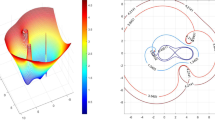Abstract.
Spectra and pseudospectra of matrix polynomials are of interest in geometric intersection problems, vibration problems, and analysis of dynamical systems. In this note we consider the effect of the choice of polynomial basis on the pseudospectrum and on the conditioning of the spectrum of regular matrix polynomials. In particular, we consider the direct use of the Lagrange basis on distinct interpolation nodes, and give a geometric characterization of “good” nodes. We also give some tools for computation of roots at infinity via a new, natural, reversal. The principal achievement of the paper is to connect pseudospectra to the well-established theory of Lebesgue functions and Lebesgue constants, by separating the influence of the scalar basis from the natural scale of the matrix polynomial, which allows many results from interpolation theory to be applied.
Similar content being viewed by others
Author information
Authors and Affiliations
Corresponding author
Additional information
This work was partially funded by the Natural Sciences and Engineering Research Council of Canada, and by the MITACS Network of Centres of Excellence.
Rights and permissions
About this article
Cite this article
Corless, R.M., Rezvani, N. & Amiraslani, A. Pseudospectra of Matrix Polynomials that Are Expressed in Alternative Bases. Math.comput.sci. 1, 353–374 (2007). https://doi.org/10.1007/s11786-007-0010-x
Received:
Accepted:
Published:
Issue Date:
DOI: https://doi.org/10.1007/s11786-007-0010-x




